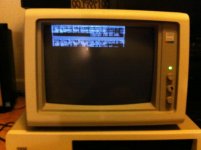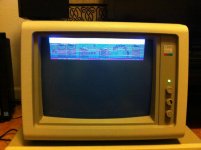bjorn_and
Experienced Member
Hi!
I just got myself an XT-286 with a 5154 monitor. The computer is in almost mint condition, however the monitor is not OK. The image, no matter what video mode, gets compressed and distorted to about the upper one fourth of the display as in the image below (I have tried connecting it to a CGA card, tried different EGA modes etc., same result always.):

I ran the EGA card on a 5153 monitor (after changing DIP-switches) and the card seem to work perfectly OK just to rule that out.
I've been googling and searching this forum, but haven't found a satisfactory solution to the problem. I know a guy who used to repair TV's so my plan is to send it to him, but it would be good to give home some clues for where to start looking. (Actually, I found one poster who had the same problem, but he never got a reply to his post as far as I could see.)
Also, is there anyone who has access to the schematics of this monitor or knows where I can find it? I'm pretty sure it will be needed if I'm going to send it away for repair.
Thanks!
Björn
I just got myself an XT-286 with a 5154 monitor. The computer is in almost mint condition, however the monitor is not OK. The image, no matter what video mode, gets compressed and distorted to about the upper one fourth of the display as in the image below (I have tried connecting it to a CGA card, tried different EGA modes etc., same result always.):

I ran the EGA card on a 5153 monitor (after changing DIP-switches) and the card seem to work perfectly OK just to rule that out.
I've been googling and searching this forum, but haven't found a satisfactory solution to the problem. I know a guy who used to repair TV's so my plan is to send it to him, but it would be good to give home some clues for where to start looking. (Actually, I found one poster who had the same problem, but he never got a reply to his post as far as I could see.)
Also, is there anyone who has access to the schematics of this monitor or knows where I can find it? I'm pretty sure it will be needed if I'm going to send it away for repair.
Thanks!
Björn

